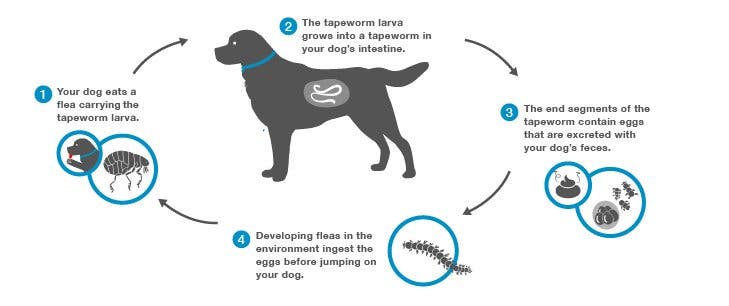How to spot the symptoms of tapeworms in dogs.
Tapeworms are a common parasite in dogs. Tapeworms can live in the intestine for a long time before you may notice any symptoms, such as:
This simple guide will help you spot the symptoms of tapeworms.
How Do Dogs Get Tapeworms?
Several different types of tapeworms can infest your dog, including the Taenia and Echinococcus species, which your dog can pick up from eating infected animals while hunting or scavenging. However, the most common tapeworm in dogs is Dipylidium caninum, contracted through fleas that carry the worm larvae. A dog can ingest these infected fleas when grooming. The larvae then attach themselves to the dog’s gut before growing into flat, white worms that can grow up to 27 inches long.
Once in the dog’s intestines, these worms feed slowly, stealing critical nutrients meant for your dog. Infected pets shed small, mobile, egg-filled worm segments in their stool. Fleas in the environment may ingest eggs from these segments, and the cycle repeats.

- Your dog eats a flea carrying the tapeworm larva.
- The tapeworm larva grows into a tapeworm in your dog’s intestine.
- The end segments of the tapeworm contain eggs that are excreted with your dog’s feces.
- Developing fleas in the environment ingest the eggs before jumping on your dog.
Good to know: Tapeworms and other intestinal parasites can pose a threat to people, too. Learn more about whether you can catch worms from your pet.
What are the Signs and Symptoms of Tapeworms in Dogs?
Dogs often do not show noticeable symptoms for a long time after infection, but that doesn’t mean you can’t spot them if you know what to look for.
Worm Segments in Your Dog’s Poop
As the tapeworm grows, some of its segments containing heaps of eggs will be released into your dog’s feces. They may also be seen around your dog’s bottom or in their bedding. These segments may look like moving pieces of rice or dried-out, hard yellow specks that can stick to your dog’s coat.
Scooting on Their Bottom
If infected, your dog may scoot around the floor or bite or lick their bottom to try to relieve the itching caused by the tapeworm. However, remember that dogs scoot for many reasons, such as blocked or irritated anal sacs or skin inflammation. Take your dog to the vet to understand what may be causing their discomfort.
Vomiting
As the tapeworms grow inside your dog, they may cause vomiting. Of course, vomiting can indicate a variety of other problems, from indigestion to more serious conditions. If your dog vomits frequently or displays other symptoms, such as lethargy or severe diarrhea, see the vet immediately.
Weight Loss
In extreme cases of tapeworm infection, your dog may lose weight despite eating normally. This is due to the tapeworm feeding on the nutrients in your dog’s intestines.
Like vomiting, weight loss can have a variety of causes. If there are no obvious reasons for the weight loss, such as increased exercise or a change in diet, then your dog might need to visit a vet for assessment.
How to Get Rid of Tapeworms in Dogs
Although tapeworms can cause alarming symptoms in your dog, they are easy to treat and remove. Worming medications can effectively kill worms lurking in your dog’s gut.
Like most infestations, prevention is better than cure, and there are a number of steps you can take to help protect your dog from parasites. One way is to maintain a regular flea treatment schedule, whether you use a spot-on, a collar or an oral medication. Additionally, check your dog’s coat regularly for fleas to help steer clear of the potentially parasite-carrying pests.
Keeping your dog from roaming unsupervised can also help prevent them from contracting Taenia or Echinococcus tapeworms from hunting rodents or rabbits, or from scavenging dead livestock such as sheep or cattle.
Thankfully, tapeworms rarely cause severe complications for dogs — and with a few simple preventive measures, you can help protect your dog from this intestinal nuisance.

Quad Dewormer (praziquantel/pyrantel pamoate/febantel) for Dogs
Nonprescription broad-spectrum dewormer that is effective against tapeworms, roundworms, hookworms and whipworms. Not for human use. Keep out of reach of children.

Drontal® Plus (praziquantel/pyrantel pamoate/febantel)
Drontal® Plus is a safe and effective way to treat and control the most common intestinal worms in dogs. Available with a veterinarian's prescription.

Tapeworm Dewormer (praziquantel tablets) for Dogs
An easy and effective way to remove common tapeworms from dogs. Not for human use. Keep out of reach of children.
Quad Dewormer (praziquantel/pyrantel pamoate/febantel) Chewable Tablets for Dogs
USES:
Quad Dewormer (praziquantel/pyrantel pamoate/febantel) Chewable Tablets for Dogs will remove common tapeworms (Diplydium caninum and Taenia pisiformis), remove common hookworms (Anclostoma caninum, Unicaria stenocephala), remove common roundworms (Toxocara canis and Toxascaris leonine) and remove whipworms in dogs (Trichuris vulpis).
Important Safety Information:
Consult your veterinarian for assistance in the diagnosis, treatment and control of parasitism; consult your veterinarian before administering the tablets to weak or debilitated animals; do not deworm a dog or puppy that is sick; consult your veterinarian for diagnosis of the illness and appropriate care. Not for use in puppies that are younger than 3 weeks of age or dogs weighing less than 2 lbs. May be given directly in the mouth or offered in a small amount of food. WARNING: Keep out of reach of children.
For complete directions for use and safety information see product label.
Drontal® Plus (praziquantel/pyrantel pamoate/febantel) for Dogs
Indications:
Drontal Plus: This drug is indicated for removal of Tapeworms (Dipylidium caninum, Taenia pisiformis, Echinococcus granulosus, and removal and control of Echinococcus multilocularis). For removal of Hookworms (Ancylostoma caninum, Uncinaria stenocephala), Ascarids (Toxocara canis, Toxascaris leonina), and Whipworms (Trichuris vulpis) in dogs.
Important Safety Information:
Drontal Plus: CAUTION: Federal (U.S.A.) law restricts this drug to use by or on the order of a licensed veterinarian. DOSAGE: Not for use in puppies less than 3 weeks of age or weighing less than 2 lbs. CONTRAINDICATIONS: Do not use in pregnant animals. WARNING: Keep out of reach of children. For full safety information, see product label for tablets or product label for taste tabs.
Tapeworm Dewormer (praziquantel tablets) for Dogs
USES:
TAPEWORM DEWORMER (praziquantel tablets) FOR DOGS will remove the common tapeworms, Dipylidium caninum and Taenia pisiformis, from dogs and puppies.
Important Safety Information:
WARNING: Keep out of reach of children. Not for human use.
Not intended for use in puppies less than four (4) weeks of age. For complete directions for use and safety information see product label.





